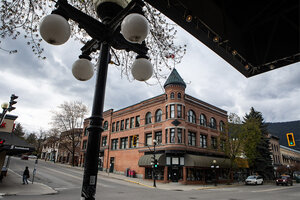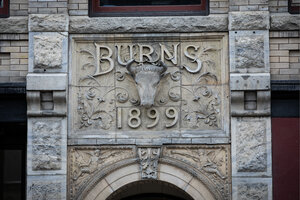A silver rush built Nelson, British Columbia. It still has polish.

YOU’RE THE TOPS: The K.W.C. Building is capped with the only remaining turret on Baker Street in downtown Nelson, British Columbia.
Melanie Stetson Freeman/Staff
Nelson, British Columbia
The remote city of Nelson, in British Columbia, boasts on its website that it “has been called the prettiest small town in Canada.” With over 350 buildings lovingly restored to reflect the city’s founding in 1897 during a silver rush, Nelson attracts its fair share of artists seeking refuge in its charm and movie directors looking for the quintessential “small town” as a backdrop.
That restoration work also drew our photographer Melanie Stetson Freeman for this photo spread while I was on a larger reporting trip in the area. She admits that she was underwhelmed at first. Downtown Baker Street, set amid the dramatic Selkirk Mountains and glacier-fed Kootenay Lake, is as charming as any Main Street can be, but many designated “heritage” homes are spread out, mixed into the surrounding neighborhoods. This lends Nelson a feel of authenticity, Melanie came to see through her lens. It’s not a preserved tourist attraction but a living, breathing place with an evolving history that has also drawn Christian pacifists from Russia, known as Doukhobors, and Americans who sought to avoid the Vietnam War draft.
Melanie’s favorite building is the one that housed P. Burns and Co., once the largest meatpacking company in western Canada. She points to the artistry of a sculpture of a cow’s head that is featured above the “1899” engraving at the entrance – a three-dimensional adornment rarely seen on facades today. “You can tell this used to be an affluent town because of the intricate carvings and decorations” on many buildings, she says. “They don’t build them like this anymore.”
Why We Wrote This
Restoration work can leave a city feeling like a preserved tourist attraction. But Nelson, British Columbia, is a living, breathing place with an evolving history.
For more visual storytelling that captures communities, traditions, and cultures around the globe, visit The World in Pictures.

